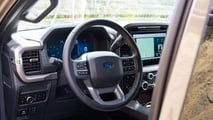
Americans are talking past each other. One side is pushing hard for wide-scale electrification, urbanism and clean transportation. The other is furious about being pushed into products that are more expensive and less capable than what they could buy yesterday. It’s not that either is wrong; they just don’t understand one another. In the automotive world, the flashpoint of this debate is the big, honkin’ trucks that rule our interstates.
Are they good, or are they bad?
They are complicated. Because while the enviro-optimist in me knows that they are an unsustainable, potentially deadly addiction, the enthusiastic, outdoorsy side of me thinks they’re the greatest consumer products ever invented. They offer an unbelievable amount of capability, versatility and durability to working-class people, and are built to be repaired and in service for decades. And even the most ardent EV fan will probably admit that all-electric trucks still struggle with key truck functions, like towing, hauling and long-distance range. It’s likely why this field remains relatively small, even in America, where trucks reign supreme.
Gallery: Ford F-150 Powerboost Hybrid







The solution, as ever, is compromise. We cannot ask people to fully give up their trucks—which they already struggle to afford—for more expensive, less proven options. Yet we cannot also live in a world where everyone is getting 16 mpg while driving, unladen, to work.
The solution, for now, is the hybrid pickup truck. It’s no one’s idea of perfect. But it’s here, and it works.
The Dilemma
Many critics rightly point out that the average truck owner does not use many of the capabilities of a modern F-150. That’s certainly true, but it fundamentally misunderstands what truck owners buy. While car and crossover owners broadly pay for increased comfort and luxury while doing their day-to-day driving, the premise of a truck is different. They are sold on capability, defined in two parts: How much can you take, and how far can you take it, for the money?
Capacity and capability reign supreme. It imbues trucks with a sense of adventure that, used or not, is often perceived as being worth the money. (And we cannot ignore the millions of truck drivers who actually use their trucks as intended, for work, pleasure or even both.) A modern truck will solve any of your transportation problems—now or tomorrow—for a decade. It’ll offer more passenger space than many SUVs, more cargo space than anything, enough luxury features to satisfy any desire and, most importantly, it’ll take you and your stuff wherever you’re going.

Viewed through this lens, it’s easy to see why the electric trucks have failed to capture a sizable proportion of this market. Truck buyers aren’t interested and, as two recent experiences showed me, they’re not entirely wrong.
A Tale Of Two F-150s
Last summer, I did a 600-odd mile road-trip in an electric Ford F-150 Lightning. Then two weeks ago, I took a 600-mile road trip in a Ford F-150 Powerboost hybrid. Both trucks were quiet, comfortable and loaded with more tech than I want. But I only wanted to take one home.
Despite working for InsideEVs, I’m sorry to say that it wasn’t the Lightning. I’m a truck guy at heart, and while I want to see this market go fully electric, the hybrid is probably a better option for today’s buyer.

On both capability and value—the two metrics of paramount importance—modern EV trucks are a tough sell. They are quieter, smoother and offer lower running costs than a gas truck in most circumstances. But the F-150 Lightning starts at over $63,000, and while many dealers will unload them for less, that’s $20,000 more than the cheapest crew-cab F-150. (Lightnings only come with four doors). Now, the Lightning offers far more standard equipment than a work truck F-150, but even accounting for that the EV is going to run you at least $10,000 more. The Powerboost hybrid powertrain, meanwhile, is a $3,560 option on a 4x4 truck.
While the driving experience of the F-150 Lightning is certainly superior to the gas F-150, you don’t get capability benefits. The highest-rated gas F-150 can tow 13,500 lbs, the hybrid can tow up to 12,700 lbs and the EV can pull 10,000 lbs. Now, all of these numbers are higher than what the average weekend warrior is putting behind their truck, but it’s a competitive metric in this segment. For max payload, the Powerboost tops out at 2,120 lbs. The Lightning can go up to 2,235 lbs, but get the extended-range battery—trust me, you will want to—and that drops to 1,952. Meanwhile, trucks with the 5.0-liter gasser can haul up to 3,315 lbs.

Real-world versions of these trucks are not going to hit any of those numbers. Option your truck with a crew cab, 4x4 and other luxury options, and you’ll quickly dip toward Lightning numbers. Since the Lightning only comes in crew cab, 4x4 configuration, it’s fine as far as capability goes. But when you consider that it doesn’t offer Ford’s FX4 off-road pack, doesn’t have a locking differential and comes with a less off-road-friendly independent rear suspension, you can’t avoid that you’re making a capability sacrifice.
Then there’s range. A perfectly specc’ed F-150 Lightning with the extended range battery can offer up to 320 miles of EPA range, but with two caveats. The first is that extended-range trucks start at $70,885. The second is that EPA range figures are for a mix of 55% city driving and 45% highway driving. As these brick-shaped trucks are far less efficient on the highway, your real-world 100-0% range is going to be around 270.3 miles, per our pal Tom Moloughney.
Factor in that, on a road trip, you’re not going to run to 0 nor charge to full (as charging slows dramatically above 80%), and you get a 10-80% range of 189 miles before you put anything in the truck. So now we arrive at the “road trip problem.”
The Road Trip Problem
It is endemic to the EV and EV reviewing world. On the one hand, consumers do not take road trips nearly as often as they think they do. On the other, people spending $70,000 on a truck expect to be able to take it wherever the hell they want to go. Across my two 600-mile trips, only one of the trucks lived up to that mission.
The F-150 Lightning was just too inefficient to be a road-trip truck. Add a trailer or a bed load of camping gear and things only get worse. The F-150 Powerboost, meanwhile, had over 600 miles of range showing on a full tank. And with a 22-mpg average over mountain terrain and meandering backroads, it wasn’t too thirsty either. In such hilly terrain, I wouldn’t expect to crack 19 mpg in most trucks. (MPG also doesn’t scale linearly; the difference between 19 and 22 mpg, 16%, is far bigger than the difference between 37 and 40 mpg, 8%.) Its CO2 emissions, too, were about 20% lower than a comparable gas-only truck.

Here, you’d expect cost to be the big differentiator. In day-to-day driving, an EV is far cheaper to run. But shift your electricity demand from at-home power rates to peak-hour DC fast charger rates, and the balance shifts. Through many stations in Ohio and Michigan, I was paying between $0.50 and $0.63 a kWh. Around $0.56 was the average, meaning I’d pay $68.88 to go from 0-100% in a 123-kWh truck. With 300 miles of claimed range on my example, that’s around $0.23 per mile, assuming you hit the EPA figure, which you won’t.
Meanwhile, the Powerboost delivered 22 mpg in mixed driving. Assuming you get gas at the national average price, you’d pay $43.50 to go 300 miles. So the Powerboost was not only more capable on the dirt, more worry-free on the highway and cheaper to buy, it was also cheaper to operate on a road trip.
Again, though, this is the exception. Most driving doesn’t take place over long distances, and for around-town trips the F-150 Lightning is a cheaper, more pleasant vehicle to run. Its silky electric drivetrain is nicer than the Powerboost’s occasionally choppy delivery, and its independent suspension gives it a better ride. With no tailpipe emissions, it also protects the natural spaces truck owners like exploring and recreating in. That’s an important benefit, but one that many buyers won’t pay up for.

A Gateway Drug
I firmly believe that the all-electric experience is better. A truck that can power your home after a storm, run your job site tools all day, run the climate control all night while you camp in it and charge up while you sleep is a versatile and compelling multitool. But the experience is not yet fleshed out. From overpriced fast charging and bad road-trip range to a charge door issue that knocked my first F-150 Lightning out of commission, the F-150 Lightning made me deal with first-adopter problems.
That will fade. We’ll get denser battery chemistries to cut down the curb weight, cheaper cells to offset the price gap and much better charging infrastructure in rural areas. All of that is coming. It is not here yet. Neither are plug-in hybrid or extended-range electric trucks, both of which can help plug the infrastructure gap.

But hybrids are here. The Ford Maverick Hybrid is the best affordable truck of any propulsion, at least in America. The Toyota Tacoma Trailhunter is a perfect fit for off-roaders. The F-150 Powerboost offers the ProPower Onboard power-export capability of an electric truck, but with the security of gas.
These are perfect gateway drugs. As customers experience the smoothness and efficiency that an electric motor offers, and the possibilities of a high-voltage power supply that rolls with them, they’ll become more open to EVs. They want capability, value and reliability, and in the long term I think EVs will exceed internal-combustion trucks on all three fronts.
It’s the automotive industry’s job to deliver that future. Here, they face conflicting interests. Their gas trucks are the moneymakers, and they don’t want to push profitable gas truck buyers into money-losing EVs. The current approach, though, isn’t working. Truck buyers are too discerning to buy uncompetitive products, and if the Big Three don’t convert them to EVs, some other company will.
Contact the author: Mack.Hogan@insideevs.com.







